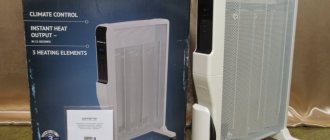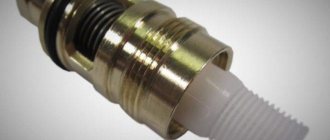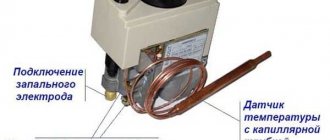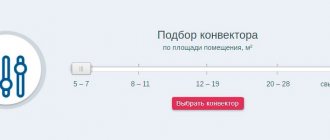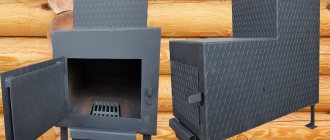The modern era of advanced smartphones and the global Internet offer users the opportunity to use advanced management and control systems. Many people use chillers and VRF systems. But the greatest demand today is for remote control. Thanks to this, you can ensure that the house does not freeze, and that a minimum positive temperature is always maintained in all rooms.
Universal remote system for phone and tablet
Ideal for a classic cottage
In remote regions of Russia, the market offers a relatively small range of heating units. Most often, dachas are heated with compact stoves burning coal or wood; in the best case, the owners of such real estate can install a solid fuel boiler or electric radiators. But even with implemented systems running on diesel fuel and natural gas, universal automatic switching is not always provided. The only viable option in this case is to use electricity. But since the use of such heating units is quite expensive, it is better to use this method as an auxiliary one.
The remote control method allows one or several rooms to be heated to the specified level before the owner arrives, while ensuring the stable functioning of the sewerage and water supply systems. After which you can start the main heating system in a comfortable environment, but only in manual mode.
The evolution of modern technology
Difference from radiator
To make a choice between two types of heaters, you need to know the difference between a convector and a radiator. We already know the structure and operating principle of the first device. Now let's examine the radiator.
Design and principle of operation
A radiator is a hollow metal structure filled with coolant. In electric models this is mineral oil, in central heating systems it is water. But we are only interested in oil (electric) radiators.
A heating element is located inside the cavity. First, it heats up itself, then it transfers heat to the oil, which shares thermal energy with the body. Only then does the air, touching the heated metal, become warm, and it floats up. Here we are also talking about convection, but the heating path is too long and expensive.
High quality GSM sockets
Timely remote switching on of a heater in use in a small dacha using such a device is the best option. It is best if there are two adjacent rooms, and the total number of convectors in power does not exceed 3.5 kW, since this figure is the permissible load for one outlet. Of course, some advanced models allow you to connect an electronic device with a maximum load of 4 kW.
The GSM socket is very convenient and practical to use. The user only needs to connect all the heaters one by one and plug the unit into a regular wall outlet. The device has a special sensor for measuring the ambient temperature. If there are many rooms in the dacha, and all the heaters are plugged into one outlet, then in the main room the air will warm up to the required level, but in all the others it simply will not have time. The whole point is that the infrared temperature sensor will switch off exactly at the moment when comfortable conditions are created in the room where the GSM device is located.
Important! The adapters in question do not have a battery, which is why in the event of an unscheduled power outage they also cease to perform their functions. The device will inform the user in advance about the current situation. After 3 minutes the system resets. After turning on the power, you must again make the desired request and send the command.
Only advanced models can boast of having an autonomous power source. Such a device retains all the settings made even after the power supply is restored.
Smart socket for remote control of the heater
If for some reason the heaters on the market with Wi-Fi are not suitable for you, then you can use a smart socket. I’ll say right away that you can find both Wi-Fi and Zigbee sockets on sale. The second option requires a gateway to work and is suitable for those who will not be limited to just one outlet and plan to purchase some sensors or other smart home devices in the future. For example, it will be possible to add a Zigbee temperature sensor and configure the socket operation scenario depending on its values.
With a Wi-Fi outlet everything is simpler. We bought any one (suitable in terms of power), connected a convector to it and received remote control. And if you have a Yandex speaker, then by purchasing a compatible socket, you can also control the convector with your voice.
I will list some options for Wi-Fi sockets that you can buy:
- Xiaomi Smart Plug ZNCZ05CM. Works in the Xiaomi smart home ecosystem, controlled both through the application and through Yandex Alice. You can connect electrical appliances with a power of up to 3680 W.
- Yandex socket YNDX-0007W. It works in the Yandex Alisa smart home; the connected load is similar to a device from Xiaomi.
- There are also SBER Smart Plug, Aqara Smart Plug (up to 2.3 kW) and from many other manufacturers.
A huge advantage of using Wi-Fi outlets is the ability to operate together with an existing heater. Additionally, I would like to note that when buying such an outlet, you should take into account that the device connected to it must have a mechanical power button, that is, turn on when power is applied. Almost all convectors are equipped with a mechanical power button, but it is better to make sure when purchasing.
High quality GSM block module
This device should be included in the electrical circuit if the house has a large area and many rooms. This block module does an excellent job of controlling all convectors in the house via a contactor, power relay, or expansion relay boards. In this case, professional installation will be required. There is enough free space in the internal compartment of the device to install a SIM card. It is better to choose an operator that has reliable signal distribution; you also need to remember to deposit money into your account.
The module is equipped with a battery that supports autonomous operation for 12 hours. In this case, manufacturers have provided a whole list of commands for controlling convectors; the user can also independently connect additional options to increase the autonomy of the product. The following functions are available from a regular mobile phone:
- Maintaining optimal temperature of heaters.
- Simultaneous connection of up to 5 sensors using a contactor.
- Remote adjustment of temperature control settings in the entire house or individual rooms.
- Using a backup battery.
- Continuous monitoring of the presence of 220V voltage in the network.
- Automatic display of information about the temperature in the house.
- Emergency notification via SMS about failure of engineering equipment.
Demanded GSM based system
Features of GSM temperature sensors
The device provides continuous temperature measurement in the controlled area and its continuous comparison with the threshold value, which is stored in the product’s memory. When the limit value is reached, the sensor sends an alarm signal via SMS message or by calling the owners' phone numbers. This allows you to protect property from fire and other unforeseen situations.
GSM temperature sensors have the following advantages:
- possibility of remote control using special service SMS commands. With their help, you can obtain information about temperature conditions, turn off electrical appliances, etc.;
- wide range of operating temperatures and stability of readings;
- Possibility of integration into a comprehensive security system. This allows you to automatically call the fire department when the permissible temperature is exceeded, maintain the temperature at a given level, turning the heating on and off;
- the ability to work both in autonomous mode due to the built-in battery and from an external power source;
- all the necessary software for the operation of the GSM temperature sensor is already installed in the device’s flash memory;
- versatility of use at various sites.
What is the limit of modern automation? This article will highlight the issue of remote control of the home electrical network using a GSM/GPRS signal. Turning on landscape lighting at your dacha by sending an SMS, or having a complete interactive diagram of the entire energy system at home is possible thanks to new technologies.
The remote power control system can be used both in country houses and in apartments to remotely turn on heating, control lighting, creating the effect of presence at the time of departure, and so on. You can establish control in any electrical network, including an existing one. The technology is based on the operation of logical controllers that receive commands via one of the GSM/CSD/GPRS communication channels and execute either them or the corresponding command scripts.
Carrying out control stationary, as well as using SMS commands
To turn on the heaters in a timely manner, you need to place a classic SIM card in the module. The necessary command is transmitted from any smartphone, after which the device will communicate with the control unit and the convectors will be configured via radio signal. You can also install a universal program, thanks to which you can specify the following parameters: on and off times, room temperature. In remote mode, you can completely reconfigure the system. In addition to this, the unit is equipped with outputs for connecting to alarm sensors.
An accessible and easy-to-use device
Pros and cons of equipment
Heating convectors have many advantages that speak in favor of this type of heating:
- Simple installation and simple work. They purchase the device, install it on legs, or hang it on the wall, connect it to the electrical network, and everything is ready to go. You just have to wait a bit until the air warms up.
- Long service life, designed for 15 years or more. No special maintenance is required. You just need to wipe off the dust in time so that it does not get caught in the upward air flow.
- The undoubted advantage is the relatively low price.
- No intervention is required to maintain the temperature; it is set once, when turned on, and changes at will.
- Quiet operation. Mechanical models make a characteristic clicking sound when the thermostat is activated, but electronic models operate completely silent.
- A simple principle of operation, with efficiency reaching up to 95 percent.
The devices also have disadvantages that need to be taken into account:
- Noticeable energy consumption;
- It is not advisable to heat large areas; in this case, the operating principle of an electric heating convector can be used as an additional source of heat.
- If the dust is not wiped off in time, the needle heaters will burn it, releasing a characteristic unpleasant odor.
Multifunctional Wi-Fi
In this case, experts recommend using Energy Control. You can download this program to any phone, which stands out for its versatility and practicality. The purchased unit is connected to the router and provides a good connection to the Internet. At work or while driving around the city, you can control convectors, adjust the air temperature, and monitor the performance of the entire system. You can simultaneously make all the necessary corrections from more than 250 smartphones.
Important! Today, Nobo is the only company that is actively working in this industry. Specialists continuously modernize and expand the functionality of the equipment they sell.
The video provides instructive information on how you can remotely control your home heating:
Electronic and mechanical thermostats
There are two types of electric convectors on the heating market - with mechanical and electronic thermostats. A convector with a mechanical thermostat is the simplest heating device, cheap and reliable. The same finned air heating element is present here, connected to the mains via a thermocouple. As soon as the air in the room heats up to a predetermined level, the bimetallic plate opens the contacts and the heating stops .
As you can see, there is nothing complicated in the design of a convector-type heater with a thermostat.
Gradually cooling down and giving off heat to surrounding objects, the cooled air will trigger the thermostat and close the contacts - the supply of electricity to the heating element will resume, heating will continue. All this will be repeated in a circle while the equipment is connected to the mains. This ensures support of the specified temperature regime.
Unlike electric convectors with electronic thermostats, models with “mechanics” cannot boast of precise temperature control. Most often, the degree of heating is set in some abstract units - for this, the units are equipped with rotary controls with numbers from 0 to 9. To set the most optimal mode, you will have to conduct a series of experiments.
There is nothing complicated about this - try starting from the middle of the scale, and then adjust the temperature in one direction or another, guided by your feelings.
Electric convectors with mechanical thermostats have a very simple design - there are no electronic control systems, which indicates their increased reliability. All this leaves a characteristic imprint on the cost of the equipment - it is quite affordable for most consumers. But you won’t have to count on any additional functionality here - there will be no program work or other “goodies” on board.
More advanced electric convectors with electronic thermostats are heating units that can ensure the creation of optimal temperature conditions. An accurate indication of the temperature will allow you to get comfortable and warm conditions during the day, and cooler conditions for quality sleep at night - you just need to set the required temperature .
For example, during the day the optimal temperature varies between +21-24 degrees, and at night it can be lowered to +18-19 degrees - sleep in the cool will be better, deeper and more useful.
Electric convectors with digital control are easier to operate than their mechanically controlled counterparts.
Let's take a look at the features of convectors with an electronic thermostat:
- There are additional functions, such as “anti-freeze”;
- Easier setting of the desired temperature using a thermostat;
- Some models have remote control.
To ensure basic functionality and create additional functions, the design of electric convectors with electronic thermostats contains electronic control modules with temperature sensors. They monitor the air temperature, control the supply voltage to the heating elements, and display information about operating modes on various indicators.
Remote systems NOBO Energy Control
It is quite easy to use such developments of specialists. Control is carried out through a single center - Orion 700 devices. Auxiliary elements allow you to remotely control absolutely all electrical appliances and convectors. The user can remotely control energy consumption. Experts made sure that the temperature was maintained exactly to 1 °C. Radiators are turned on and off according to a given program, and the universal built-in timer can be programmed not only for a day, but also for a whole week. Thanks to this, the final electricity consumption is reduced by 30%, but without compromising the comfort of living.
Why do you need GSM control?
You can easily figure out how to use the device to control devices from your phone. Its main task, as the name implies, is load management. This is to turn them on or off. In other words, it's just a switch, but we can control it from our cell phone. With this device we can control absolutely any load in on and off mode.
For example, at the dacha. We have an input panel that distributes electricity throughout the entire dacha. In a hurry to get home, you may forget to turn off the automatic switch, and accordingly, the switched-on appliances, such as a fireplace, will remain on. Having already reached home, you remember this, and the dacha is 100 km away. Go back and turn it off? Of course, otherwise the dacha can very quickly turn into a pile of ashes. Or you can set the load control using your phone and turn everything off using your phone.
You can do the same in an apartment. The main thing is to separate the electrical wiring in advance so that the refrigerator and other important appliances do not turn off. Which ones are up to you to decide. Although almost every GSM relay can control several groups of loads and, accordingly, with several commands, we can turn on and off different groups. The electrical panel can be configured to disconnect the entire load EXCEPT and ABSOLUTELY the entire load. This is quite easy to do.
Most of these devices are equipped with an input for a temperature sensor, so we can remotely control heating devices in the room. Thus, the heating will not work constantly, but only when we need it. This means we can also save electricity with it.
At the same dacha, we can remotely turn on the heated floor or fireplace in advance in order to arrive in an already warm room, and since the device is equipped with its own sensor, it will send you an SMS in advance when the temperature reaches the desired one.
Also, using the GSM module, you can remotely control irrigation, pumps and lighting. The application options are endless. After all, the main thing that these devices can do is control the load. And this is exactly what we need - to comfortably and remotely turn on or off certain electrical appliances. We want to do this for various reasons. Some due to forgetfulness, others want to turn on something in advance.
For those who forget to turn off the lights and iron, as well as for those who want to arrive early at a warm dacha even in winter. Who can’t come to water their favorite flowers three times a week and don’t want them to dry out? Automation has been in our lives for a long time and is only gaining momentum; you must agree, it is very convenient. And how much joy people experience when they begin to control such seemingly complex technologies with their own hands.
offers to buy a temperature sensor with a GSM module. This device is designed to control the temperature regime at a protected facility. It is widely used in residential and warehouse premises, greenhouses, incubators, cellars, garages, etc. Such sensors allow you to monitor the situation near heating and heating equipment. They are also an important component of smart home systems.
Our assortment includes GSM temperature sensors that are highly sensitive and reliable. You can purchase them at the best prices and with the possibility of delivery throughout Moscow and Moscow Region by our company’s own courier service. For customer convenience, we offer several payment options and provide professional assistance in choosing the appropriate equipment.
Activation of heating at a certain time
To create optimal living conditions at your dacha, you can set your arrival time in advance. This option suits many modern users with its accessibility and simplicity. To work, you need to purchase a reliable automation relay. The timer is installed in a circuit with an electric heater and the optimal turn-on time is simply set.
Advice! If arrival at the dacha is planned at eight in the morning, then you need to set the relay for 5 o’clock. During these 3 hours, the air in the rooms will warm up well.
To significantly save money, heating can not be turned on in all rooms. In the living room and bathroom it is enough to bring the temperature to +12 °C. Even if a person comes in from slightly frosty conditions, such conditions will be comfortable. To avoid wasting electricity if the train is cancelled, you can turn off the heating remotely.
A popular device for remote use
Several general recommendations for connecting electric convectors.
Installing a heating system on electric convectors does not require any special skills, even if you are not an electrician. General recommendations must be followed:
- Do not place a total load of more than 3 kW on one line (3 convectors of 1 kW each, or 2 of 1.5 kW each)
- Connect such a line through a differential circuit breaker of at least 15A
- When connecting in series to one load line more than 3 kW, use a contactor
- When using a room thermostat or a GSM socket not manufactured by the convectors, pay attention to the permissible current for it
Sending commands from a smartphone
This option is more convenient to use, but you need to spend more money on it. In order to send a remote command that will notify the equipped system that it is time to prepare for the arrival of property owners and turn on the heating, you need to buy a GSM module. This device is a regular switch that is responsible for connecting when calling from a phone. You can enter several numbers into the unit’s memory at once, calls from which will be perceived as commands. The product must be installed in a common switchboard and high-quality electric radiators are connected through it. To have a warm room waiting for you upon arrival at your dacha, you just need to call from your smartphone or send an SMS. If you had to be delayed or the train was suddenly cancelled, then just make another call to turn off the heating.
Important! The device fits perfectly with a SIM card from any mobile operator. It is best to opt for the option that provides the highest quality communication in a certain region.
Self-installation of purchased socket
Typical connection diagrams and ready-made solutions
It is almost impossible to list all the possible uses of GSM controllers in the home. Modern SCADA systems are so diverse that they allow you to solve any household problems without exception. Standard complexes, such as XITAL GSM or ESIM120, do an excellent job with general tasks such as controlling lighting or heating. With them everything is simple: the controller is installed at the actuator and controls the power through a relay output.
Cons: you have to equip each node with a separate control module, which means confusion with mobile numbers, limited capabilities and the lack of a single control center.
There are more advanced circuit options, but you will have to assemble them yourself. Let's look at just a few typical options.
The controller performs the task of greenhouse and garden irrigation, is connected to a common control system, and is controlled remotely through it. It is possible to execute both commands and program scripts. Relay blocking will prevent an accident due to user error.
A powerful, freely programmable controller and several I/O modulators control all systems in the house, including security and alarm systems. This is one of the most advanced schemes that can be successfully integrated into a smart home system.
Sometimes one single device is enough, which is simultaneously a modem, a controller, and an I/O module. Control scheme based on the ES-ForthLogic communicator.
Maintaining positive temperature in the house automatically
Water supply is directly related to heating. If you rarely go to your dacha in winter, then you shouldn’t be too smart about the water supply. You can bring the necessary supply of liquid with you for several days, or store it in capacious plastic containers from the summer. If the dacha is visited quite often, and the water is used not only for drinking, but also for showering and sewage, then this property is used as a country house. In this case, smarter systems are needed than the classic remote switch.
If the house is periodically subjected to freezing and thawing, this is fraught with accelerated deterioration of the property’s finishing, which will force the owners to spend additional money on unscheduled repairs.
The assembly of more complex remote systems needs to be done if it is planned not only to provide high-quality heating of rooms, but also to electrically heat sewerage and water supply systems, as well as constantly maintain positive temperatures. Expensive models of boilers that operate on gaseous or liquid fuel and are equipped with a thermostat are equipped with similar functions.
Important! Heating of water pipes is based on the fact that they are wrapped in a spiral with a heating cable cord, and then covered on top with a warm sleeve, which is made of foamed polyethylene.
Affordable GSM device from a domestic manufacturer
Safety precautions
Electric convectors require careful handling, like any electrical appliances. When using them, you need to remember the techniques for safe use of such units.
For example, drying clothes directly on the body is considered a big mistake. The best outcome is for the device to overheat and turn it off if the protection is triggered. The worst case scenario is a fire.
The electrical outlet into which the convector is plugged in should be located on the side of the device, at a distance of 10 cm or more. Placing the socket on top is strictly prohibited.
If you take all these points into account, operation will be safe, the device will last a long time, and thanks to it the room will be warm and cozy.
Remote automatic heating of a standard dacha as an integral part of the overall scheme
A professional approach to real estate heating allows the equipment involved to function stably in various modes. With the right approach, you can combine several systems at once to achieve a good result. This remote correction option does not have a central controller. But at the same time, a fairly large percentage of the unused capabilities of the units can be used in other “smart home” schemes. Even a classic GSM module is capable of not only receiving incoming calls, but also sending reports about the situation in the house to a smartphone. Thanks to this, you can quickly find out about a flood or a starting fire.
Brief overview of the equipment
The first step to remote power management is purchasing the right equipment. A full-fledged power management system consists of five components, for each of the points a sample will be selected to draw up an assembly diagram:
| Type of equipment | Name | Peculiarities | Price |
| Communication module | GSM/GPRS modem "ARIES PM01" | Automatic reboot at variable intervals. Connection via RS-232 or RS-485 interfaces. Communication channels: GPRS/CSD/GSM. | 4,500 rub. |
| Programmable controller | Logic freely programmable controller "OWEN PLC 100" | Freely programmable. No pre-installed OS. CodeSys software environment with high compatibility. Four communication interfaces. | 9,000 ~ 10,500 rub. |
| Load switching | ABB ESB-20 modular contactors | 1,500 rub. | |
| Circuit breakers ABB S201 | 300 rub. | ||
| Differential automatic machine ABB DSH941 | 2,500 rub. | ||
| Environment Analyzers | Contact type sensors Semiconductor sensors Pulse counters | Limit switches: 600 rub; Reed sensors: RUB 1,400; Temperature sensor: 800-1100 rub. | |
| I/O module | Discrete input/output module "OVEN MDVV" | 12 discrete inputs and 8 outputs, operating in combined mode: electromagnetic relay, transistor switch, open collector. | 5,000 rub. |
Controller ARIES PLC 100
Remote control systems also use many peripheral devices:
- UPSs remain operational when the power is turned off.
- Relay automation blocks make the execution of commands safe.
- Software scenario generators expand the controller's capabilities.
- Wireless communication modules allow unlimited expansion of the system.
- User graphical interfaces make it possible to configure equipment without connecting to a PC.
The feasibility of remote control of functioning heating
Various heating cables, radiators, and boilers are responsible for the most comfortable air temperature in the house. Each unit has its own operating principle and heating functions. The main task of the created system is to heat the room with minimal financial losses. Having remotely set the optimal parameters of the desired temperature, the user sets a specific control program. Control can be carried out either automatically or manually. Thanks to this, the rooms will be maintained at the most suitable temperature. This approach allows you to control the functioning of not only the entire system, but also individual working units, which is very convenient and practical. The equipment will independently make the necessary adjustments when it gets warmer or colder outside.
Rational use of electric heaters in a private home
How to correctly calculate power
Before purchasing a convector, you need to find out what power will be enough to heat the room. If the power is not calculated, then energy consumption will be wasted. You can use two types of calculations: by area or by volume.
The convector power is calculated as follows:
- The area calculation is approximate and it must be kept in mind that adjustments are necessary. But this is done easily and quickly. The following norm is taken for calculation: 0.1 kW/h per 1 sq. m of room area, which conventionally has one door and one window with a ceiling height of 2.5 m. So, for example, you need to calculate the power characteristics of a convector for a room with an area of 18 square meters. m. We get the result: 18x0.1 = 1.8 kW. If the room is corner, then a coefficient of 1.1 is applied. It may also be that the room has good thermal insulation and a high-quality plastic window (with energy-saving glass), then a coefficient of 0.8 can be applied.
- Calculation by volume is more accurate, but coefficients must also be applied. For the calculation, the following dimensions are taken: width, length of the room and ceiling height. It should also be taken into account that 0.04 kW of thermal power is used to heat 1 sq. m of premises. Length, width and height are multiplied and the resulting figure is multiplied by 0.04. So, for a room where the area is 15 square meters. m with a ceiling height of 2.5 meters, a heater with a power of 1.5 kW is required.
Important. If there is more than one window in the room, then for each subsequent window you need to add another 10 percent. With good thermal insulation, the percentage can be reduced.
The calculation of the power of a convector is somewhat different if the device is used in extreme cold as an auxiliary heat source. Here we take a parameter such as 30-50 W per 1 sq. meter, if the calculation is based on area, and 0.015-002 kW per 1 cubic meter. meter when calculating by volume.
Main advantages
The main positive characteristics of the remote heating control method include:
- Significant cost savings on heating rooms (up to 60%). This effect is achieved due to the fact that in the absence of the owners the boiler can operate in an economical mode.
- Providing additional comfort and coziness.
- For high-quality engineering systems, a real development trend can be considered the possibility of combining them into a single network. Due to this, you can reduce the overall financial costs of maintaining the dacha.
- Significant extension of the service life of devices, ensured by the operation of parts at reduced loads.
Experts have proven that the capabilities of devices for remotely sending operating parameters are becoming more advanced every year. Developers of multifunctional applications for smartphones create innovative devices on the principle that even an untrained person can easily handle them. Now, even over a long distance, you can prevent pipes from defrosting during the cold season. The zonal mode of operation is in great demand, when different rooms can have individual temperatures.
Remote reconfiguration means that any indicators can be changed using a smartphone. It is this approach that is one of the key parts of the ideology of promoting a “smart home”. This approach entails the further rapid development of all engineering systems of the dacha in order to ensure the most convenient creation of comfortable living conditions.
More informative information on this topic is presented in the video:
Average score of ratings is more than 0
Share link
Comments There are no comments yet, but you could be the first...
